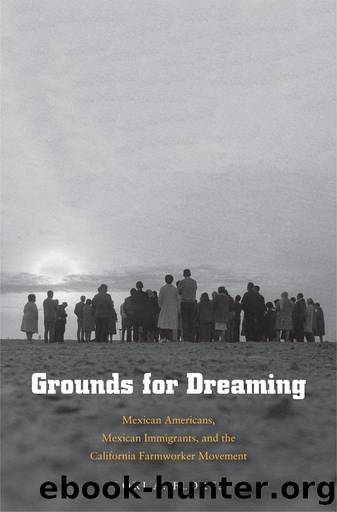Grounds for Dreaming: Mexican Americans, Mexican Immigrants, and the California Farmworker Movement by Lori A. Flores

Author:Lori A. Flores [Flores, Lori A.]
Language: eng
Format: epub
Tags: Social Science, Ethnic Studies, Hispanic American Studies
ISBN: 9780300196962
Google: _BsvCwAAQBAJ
Publisher: Yale University Press
Published: 2016-01-01T00:24:43.194523+00:00
6
The Farmworker Movement in the Post-Bracero Era
THE CONTINUED IMPORTATION of braceros in what was supposed to be a post-bracero era was a painful thorn in the side of almost four million U.S. domestic farmworkers. Often forced onto the road and into an itinerant life, they suffered from a lack of a living wage and ineligibility for health insurance, welfare, voting rights, and other resources that required an extended period of residency in one place. Even if they did find employment, they endured long days of backbreaking fieldwork with unrealistic piece rates, inadequate rest periods, and exposure to pesticides. Their average life expectancy was only forty-nine years. Many female farmworkers experienced sexual harassment on the job, and U.S. Secretary of Health, Education, and Welfare Anthony J. Celebrezze called migrant children âthe most educationally deprived group of children in our Nationâ due to their familiesâ peripatetic lifestyle. The disparity between farmworkersâ and growersâ wealth was shocking. Nationally, farmworkersâ average annual income dropped from $1,125 in 1960 to $1,054 in 1961. Even in agriculturally rich areas like Monterey County, domestic laborers averaged only 129 days of employment and $1,247 in yearly earnings. Meanwhile, Monterey County agribusiness reaped $175 million in gross farm income in 1966, ranking eighth among agricultural counties in California and eleventh in the nation. Employers were doing little to create affordable family housing for migrant farmworker families (which averaged 6.5 people) and were using the excuse of a âdomestic labor shortageâ to hire Mexican nationals. In border regions like the Imperial Valley, growers hired Mexican commuter workers early in the morning before area employment offices opened to U.S. residents.1 Although the Hart-Cellar Act in 1965 had imposed new quotas on Western hemispheric immigration, limiting entry to 120,000 people annually, these caps did not stop the flow of Mexican migrants into the country. In fact, the 20,000-person quota for Mexico fell drastically short of reality and historical immigration patterns and in effect created more undocumented immigrants whom U.S. employers were still willing to hire.
Though domestic farmworkers came from every racial background, the vast majority in the 1960s were Mexican American. By 1965 an estimated 5.5 million Spanish-speaking people lived in the United States, with between 4.5 and 4.8 million identifying as being of Mexican-origin. This population, in addition to comprising a vulnerable agricultural labor force, continued to suffer from discrimination in housing and employment, police brutality, being drafted to and killed in disproportionate numbers in Vietnam, and completing a lower median level of education than both whites and blacks. Many things had not changed, but one thing that had was the number of Mexican-origin people who were U.S. citizens rather than foreign-born. With a larger native-born population, the call for Mexican Americansâ equal treatment and citizenship during a civil rights era grew louder. It was in this climate that the Chicano Movement, or el movimiento, emerged. This movement was an expression of Mexican American ethnic nationalism and civil rights protest that flourished during the 1960s. The term âChicanoâ was believed to
Download
This site does not store any files on its server. We only index and link to content provided by other sites. Please contact the content providers to delete copyright contents if any and email us, we'll remove relevant links or contents immediately.
Zero to IPO: Over $1 Trillion of Actionable Advice from the World's Most Successful Entrepreneurs by Frederic Kerrest(4295)
Machine Learning at Scale with H2O by Gregory Keys | David Whiting(4179)
Never by Ken Follett(3790)
Harry Potter and the Goblet Of Fire by J.K. Rowling(3774)
Ogilvy on Advertising by David Ogilvy(3510)
Shadow of Night by Deborah Harkness(3303)
The Man Who Died Twice by Richard Osman(2997)
Book of Life by Deborah Harkness(2867)
The Tipping Point by Malcolm Gladwell(2827)
Will by Will Smith(2793)
0041152001443424520 .pdf by Unknown(2784)
My Brilliant Friend by Elena Ferrante(2774)
How Proust Can Change Your Life by Alain De Botton(2742)
Purple Hibiscus by Chimamanda Ngozi Adichie(2652)
How to Pay Zero Taxes, 2018 by Jeff A. Schnepper(2602)
Hooked: A Dark, Contemporary Romance (Never After Series) by Emily McIntire(2500)
Rationality by Steven Pinker(2291)
Borders by unknow(2229)
Can't Hurt Me: Master Your Mind and Defy the Odds - Clean Edition by David Goggins(2227)
